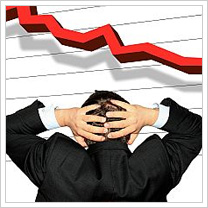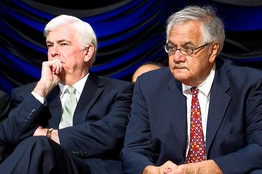Related Topics
Personal Finance
The rules of financial health are simple, but remarkably hard to follow. Be frugal in order to save, use your savings to buy the whole market not parts of it, if this system ain't broke, don't fix it. And don't underestimate your longevity.
Dislocations: Financial and Fundamental
The crash of 2007 was more than a bank panic. Thirty years of excessive borrowing had reached a point where something was certain to topple it. Alan Greenspan deplored "irrational exuberance" in 1996, but only in 2007 did everybody try to get out the door at the same time. The crash announced the switch to deleveraging, it did not cause it.
Revisionist Themes
In taking a comprehensive view of a city, an author sometimes makes observations which differ from the common view. Usually with special pride, sometimes a little sullen.
Whither, Federal Reserve? (2)After Our Crash
Whither, Federal Reserve? (2)
Taking Risks Demands Its Price

|
| downturn |
Someday, books will be written about who discovered what, and sold what, to make S & P futures suddenly go up and down 300 points in ten minutes on August 17, 2007, soon followed by violent volatility in many other markets. Confusion reigned for a few days, but within a week there was general agreement about the difficulty: the "spread" of interest rates between risky loans and very safe ones had been too narrow for months, and was reverting back to normal. Risk had been mispriced; a risky loan was just as risky as it ever was, as everyone should have realized. If the risky borrower was unwilling to pay higher interest rates, why would any lender bother with him? Since this had been obvious all along, why had lenders temporarily believed otherwise, charging rates scarcely higher for dodgy loans than for well-secured ones?

|
| Alan Greenspan |
Alan Greenspan (in 1996) had called this question a conundrum, but it's getting easier to understand. The emergence of prosperity in one decade among 200 million impoverished Chinese had resulted in wealth which found its way into international markets, much like a gold rush or the discovery of oil. Sudden huge wealth often cannot be easily assimilated, hence was available to loan at cheaper rates. The globalization of world finance has vastly improved the speed of markets to absorb money gluts, but in this case, had the unfortunate effect of spreading it out into less sophisticated corners of the world economy. It particularly affected residential mortgages, which proved to be the weakest link in the chain of lending and borrowing. Ten years of low-interest rates pushed up the prices of existing homes, tempting builders to overcharge for new construction, and inexperienced buyers to pay those inflated prices with cheap mortgages. Between them, Congress and the banks had devised ways to exploit this situation, making the collapse worse when it came. The interest on home mortgages was preferentially tax deductible, so it became the favorite way to borrow. Banks made it easier to refinance at a lower rate as the spread gradually narrowed. To make it even easier, reverse mortgages converted home ownership into an ATM machine with tax deductibility. Because home prices were steadily rising, banks were willing to reduce down payments, on the assumption that home equity would soon rise to represent the amount formerly required as a down payment. As it would have, perhaps, if homeowners had not promptly drained it out the back door of reverse mortgages. Second homes became a cheaper way to have a vacation; steadily rising prices encouraged outright speculation, called flipping. Congress reinsured mortgages, eventually most of them, through FNMA, and then pressured Fannie Mae to insist on spreading the joys of home ownership to people who could not afford the no-down-payment houses they were romanced into buying. Investment banks offered to buy the mortgages from the local originating banks in order to package them into securitized bundles, which thus deprived the originating banks of any incentive to reject eager buyers, no matter how dubious their credit standing. What is more, this process provided a conduit for spreading bad credit risk into the equity markets, including the equity of the banking system itself, and creating the temptation for hedge funds to start runs on the banks in novel forms. There once was a time when customers lined up at the back door to make withdrawals in a bank run. Since investment banks obtain their deposits by borrowing wholesale, they simplified the process of starting a bank run when the speculative process reversed. Which it did on August 17, 2007, possibly not spontaneously, but certainly inevitably.
Home mortgages were once loans for thirty years; even now, they extend for many years. Homeowners stay in one house for an average of seven years. For legal reasons going back two hundred years, they are non-recourse loans, meaning the house alone is at risk to the mortgage lender, who may normally not pursue the homeowner for assets other than the foreclosure, even if the other assets are considerable. In a housing bubble, this creates a special hazard for lenders during the inevitable decline of house prices back to normal. As house prices fall, as they should and will, many homeowners will find it is cheaper to walk away from a foreclosure than to pay off the mortgage. It has been calculated that potentially as many as 50% of mortgages might eventually find themselves in this squeeze. The situation differs from a car loan, for example. Every new car is worth 20% less than the sale price, immediately after the sale. But this does not tempt car buyers to walk away from their loan, because the car loan is a recourse loan. The uncomfortable prospect is that financial reverses alone might not be the reason homeowners submit to foreclosure. If this particular antisocial behavior loses its stigma, a very large proportion of mortgages could be foreclosed on owners who are perfectly able to pay them off.

|
| Barney Frank and Chris Dodd |
For all these reasons, house prices are the main bubble in an economy overstimulated by cheap money, and mortgage financing is at the root of a banking crisis. The banking system itself is precarious because it too responded to the temptation of abundant credit at abnormally low-interest rates. The process took the form of over-leveraging in order to magnify profits in a competitive market. Greed was not the only motivation; corporate raiders in the form of Private Equity could swoop down on any company unwise enough to accumulate internal cash. The new owner would then substitute debt for cash, and the prudent company (under new management, of course) was no better off than if it had itself over-leveraged. The Federal Reserve limits commercial banks to loaning thirteen times their stockholder equity, but investment banks had the foolhardiness to borrow thirty times equity. A decline of only three percent in the value of their loans wipes them out. The Federal Reserve Bank of New York, by the way, is leveraged at over a hundred times its equity. The Fed can print money to pay its debts, of course, but the result is a falling value of the dollar in international exchange and ultimately, world inflation. No one predicts the half-way point in this decline to be sooner than two years, which means a recession lasting at least four years. The first two efforts of public officials to halt the decline, the purchase of toxic debt and direct lending to banks, have been abandoned as failures, and the Barney Frank/ Chris Dodd offer for Congress to repurchase mortgages was simply pathetic, with only two hundred responses when over two million were anticipated. If the public loses faith in the ability of the government to do anything about the matter, prices can be expected to overshoot on the downside, not just return to normal. House prices do need to decline, but slowly enough to avoid a panic. And American banks and businesses need to reduce the extent of their borrowing, but without measures which impair the ability of new businesses to make loans, or the ability of shaky businesses like the Detroit auto industry, to survive.
In closing, a word is needed to explain why the foreclosure of $100 billion of California and Florida bungalows should threaten a collapse in the trillions. Economists have fallen into the habit of equating interest rates with risk; the more risk, the higher the interest rates become. That's true, but the risk is not the only factor affecting interest rates. Since they are essentially the rent paid for the use of someone else's money, interest rates respond to the supply of money interest rates, just as supply and demand of rental housing affect rents. The flood of liquidity from developing countries into the world economy pushed interest rates down, but somehow that was taken to imply that risk had decreased. When interest rates go up again, for whatever reason, the money will effectively evaporate. The best example of this relationship is in the bond market. When interest rates go up, the principal value of existing bonds declines. With interest rates of 5% as an example, bond prices go up and down twenty times as much as the interest rate, but in the opposite direction. To repeat: when general interest rates rise, money in the economy disappears about twenty times as fast. That's a succinct description of what started to happen, when the prevailing risk premium returned to its normal higher level, on August 17, 2007.
Originally published: Sunday, December 21, 2008; most-recently modified: Sunday, July 21, 2019
| Posted by: Mortgages | Apr 30, 2010 1:37 PM |
It’s perfect thought from my side.
</a href="http://www.ukabbeynational.com" rel="dofollow">Mortgages